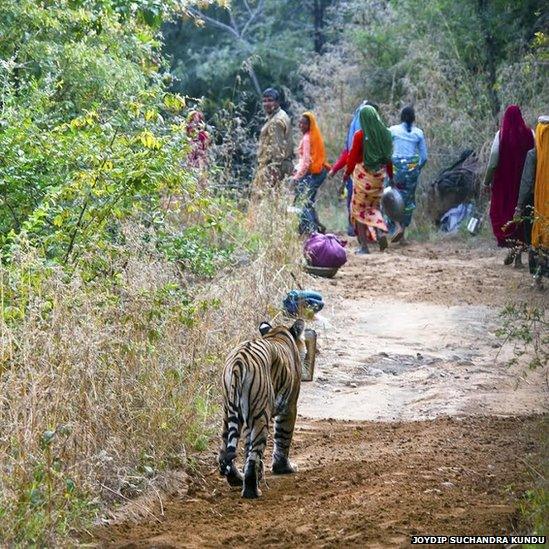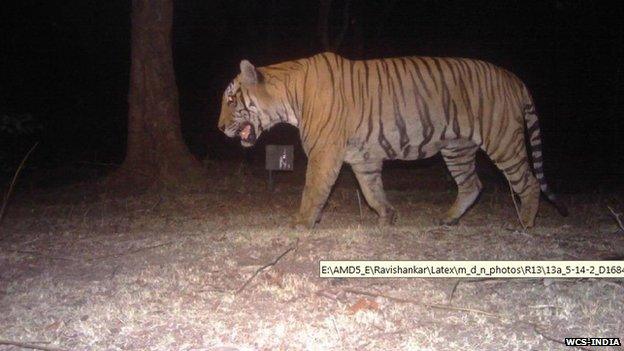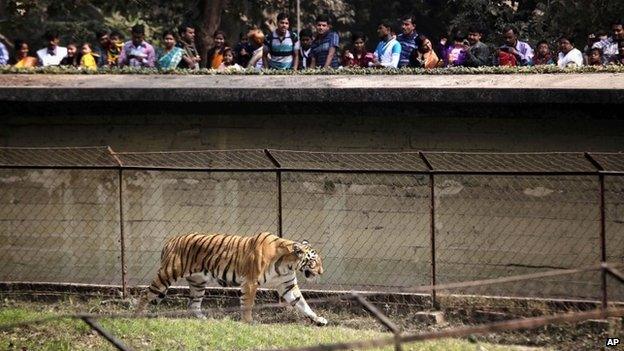Why are India's tigers killing humans?
- Published

It is not possible to describe the terror of living in the shadow of a "man-eating" tiger
There are about 1,700 tigers left in the wild in India. In the past five weeks, 17 people in four states have been killed by tigers. Jay Mazoomdaar investigates the reasons behind the current spate of killings.
In a country which is home to the world's largest population of tigers, few things swing public opinion more sharply than a "man-eater" does.
With 17 people killed by tigers in the past five weeks in the four Indian states of Uttar Pradesh, Karnataka, Tamil Nadu and Maharashtra, angry residents of affected areas are threatening to take the law into their own hands.
But then, to those who do not know it, nothing can describe the terror of living in the shadow of a "man-eating" tiger on the prowl.
In Tamil Nadu's Nilgiri district, schools in the Dodabetta region have been shut for over a week now., external The majority of the householders here are people on daily wages who have not gone to work. If the "tiger curfew" continues much longer, the poorer families may start to starve.
Drawing a blank
The tiger that killed three people since 4 January in Dodabetta has been confirmed as a "man-eater". But the jury is still out on whether a "man-eater" killed two people in Maharashtra's Tadoba region. In Uttar Pradesh, a wandering tigress from Jim Corbett National Park has killed seven people since Christmas. Another five people have been killed by a tiger in Karnataka.
While two "man-eating" tigers - and one which killed livestock - have been captured in Karnataka since last month, forest authorities in Tamil Nadu and Uttar Pradesh have so far drawn a blank.
Trap cages and camera traps are in place. Trackers on foot and veterinarians with tranquiliser guns on elephants are scouring the forest patches. Even recorded mating calls are being blared to lure the "man-eater" out. But with little luck so far.
It is never easy when a tiger loses its fear of people.
In fact, most attacks on people are chance encounters gone wrong. Victims of such accidental attacks are rarely dragged away as prey or actually eaten.
But a series of attacks on people in quick succession is a telltale sign of a man-eater at work.

Forest guards and workers give way to a tiger inside India's Ranthambhore national park
Fortunately, a tiger turning to human prey is rare.
A tiger usually makes one large kill every week. For India's 1,700-odd tigers, that adds up to more than 85,000 kills in a year.
If humans were part of a tiger's natural diet, and since there are people everywhere in India, a good number of these 85,000 kills would be humans.
The truth is, less than 85 people are killed or injured - accidentally or otherwise - in a year by tigers here. Many times more die of snakebites or rabies.
Yet, the tiger remains the most feared killing machine in public perception.
People rarely discriminate between accidental and deliberate killings. And every time there is an attack, the media jump the gun.
Under the law, the heads of the state wildlife departments can declare a tiger a man-eater and permit its killing.
'Risky delay'
But a spate of shooting licences issued to private hunters prompted the union environment ministry to issue a Standard Operating Procedure (SOP) in January last year.
According to the SOP, "under no circumstances, a tiger should be eliminated by invoking the Wildlife [Protection] Act, 1972, if it is not habituated for causing human death".
But when a tiger stalks and kills people, the only option is to eliminate it.
India's strong animal welfare lobby, however, insists on capturing "man-eaters" alive, rather than shooting them down.
It takes a lot more effort and time to trap or tranquilise a "man-eater" than to gun it down.
And every delay is fraught with the danger of more human casualties and the subsequent revenge killing of random tigers by hostile villagers.
"Once confirmed, a 'man-eater' has to be dealt with promptly. Any delay is risky and this angers local people. This may undermine public support for conservation of tigers as a species," argues tiger biologist Dr Ullas Karanth.
Conservationist Valmik Thapar insists that independent experts must be engaged to determine if a tiger is a "man-eater".

A photograph of the tiger in Bandipur which killed humans. The tiger was captured later.
"If it is established that a tiger is too dangerous to be rehabilitated in the wild, it should be put down rather than made to serve a life term in a zoo," he says.
Not surprisingly, most "man-eaters" in recent times have been reported from areas with high tiger populations, such as the Bandipur-Nagarahole, Tadoba, Corbett-Rajaji, Ranthambhore and Kaziranga regions.
Densely packed tiger forests - many call them the price of India's conservation success - often lead to young and old tigers wandering outside. Such wandering tigers are more likely to come into conflict with people.
'Too many tigers'
"Tigers that come into conflict with people are more likely sub-adults [a tiger that has passed through the juvenile period but not yet attained typical adult characteristics] trying to find new territories, and among old, injured animals that are evicted from their home territories," Dr Karanth explains.
The man-eater captured in Karnataka on 5 December was a 12-year-old male. It had nearly completed the full lifespan expected in the wild.
The one trapped on 2 January was an eight-year-old male with injuries to its right paw and shoulder.

A tiger turning to human prey is 'a rare aberration'
Since such weak animals would not have lasted too long in the wild anyway, it makes no difference to conservation if they are killed or sent to zoos, say wildlife experts.
But prompt action sends the right message to local communities.
Experts believe that the public outcry over the present spate of human killings should neither provoke officials to hastily declare the tigers as "man-eaters" nor come in the way of promptly gunning down an identified "man-eater".
"Any confirmed 'man-eater' should be eliminated, though not a tiger that accidentally kills someone in self-defence. Zoos already have far too many tigers," says Dr George Schaller, the world's foremost field biologist.
Meanwhile, life is on hold in India's terrified villages reeling from tiger attacks. The search for the "man-eaters" continues.
Jay Mazoomdaar is an independent journalist who writes for publications in India and abroad.
- Published4 December 2013
- Published15 October 2010
- Published4 January 2012
- Published22 December 2010
- Published9 November 2010